
The cicadas are a superfamily, the Cicadoidea, of insects in the order Hemiptera. They are in the suborder Auchenorrhyncha, along with smaller jumping bugs such as leafhoppers and froghoppers. The superfamily is divided into two families, the Tettigarctidae, with two species in Australia, and the Cicadidae, with more than 3,000 species described from around the world; many species remain undescribed.

Orthoptera is an order of insects that comprises the grasshoppers, locusts, and crickets, including closely related insects, such as the bush crickets or katydids and wētā. The order is subdivided into two suborders: Caelifera – grasshoppers, locusts, and close relatives; and Ensifera – crickets and close relatives.
Stridulation is the act of producing sound by rubbing together certain body parts. This behavior is mostly associated with insects, but other animals are known to do this as well, such as a number of species of fish, snakes and spiders. The mechanism is typically that of one structure with a well-defined lip, ridge, or nodules being moved across a finely-ridged surface or vice versa, and vibrating as it does so, like the dragging of a phonograph needle across a vinyl record. Sometimes it is the structure bearing the file which resonates to produce the sound, but in other cases it is the structure bearing the scraper, with both variants possible in related groups. Common onomatopoeic words for the sounds produced by stridulation include chirp and chirrup.

Mole crickets are members of the insect family Gryllotalpidae, in the order Orthoptera. Mole crickets are cylindrical-bodied, fossorial insects about 3–5 cm (1.2–2.0 in) long as adults, with small eyes and shovel-like fore limbs highly developed for burrowing. They are present in many parts of the world and where they have arrived in new regions, may become agricultural pests.

A tegmen designates the modified leathery front wing on an insect particularly in the orders Dermaptera (earwigs), Orthoptera, Mantodea, Phasmatodea and Blattodea (cockroaches).
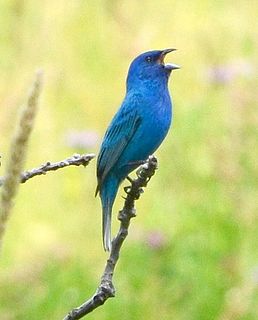
Animal song is not a well-defined term in scientific literature, and the use of the more broadly defined term vocalizations is in more common use. Song generally consists of several successive vocal sounds incorporating multiple syllables. Some sources distinguish between simpler vocalizations, termed “calls”, reserving the term “song” for more complex productions. Song-like productions have been identified in several groups of animals, including cetaceans, avians (birds), anurans (frogs), and humans. Social transmission of song has been found in groups including birds and cetaceans.
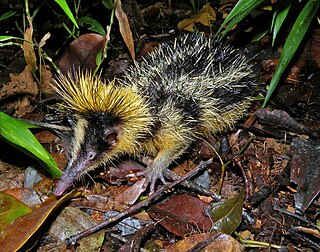
The lowland streaked tenrec is a small tenrec found in Madagascar. It belongs to the family Tenrecidae in the order Afrosoricida, and more specifically to the subfamily of the spiny tenrecs Tenrecinae. Its natural habitats are in tropical lowland rain forests in northern and eastern parts of Madagascar.
An acoustic horn or waveguide is a tapered sound guide designed to provide an acoustic impedance match between a sound source and free air. This has the effect of maximizing the efficiency with which sound waves from the particular source are transferred to the air. Conversely, a horn can be used at the receiving end to optimize the transfer of sound from the air to a receiver.
Gryllotalpa major,also known as the Prairie Mole Cricket, is endemic to the United States and is the largest cricket in North America. Its natural habitat is temperate grassland and it belongs to the family Gryllotalpidae. It is threatened by habitat loss, and is currently only found in Oklahoma, Kansas, Missouri, Nebraska and Arkansas. Males of this species produce sounds by rubbing their fore wings together. They sing from special burrows they construct in the prairie soil to attract females for mating, and they can be heard at distances up to 400 m from the burrow. Males aggregate their acoustic burrows in a lek arena and are very sensitive to vibrations carried through the ground. Males communicate with neighboring males through vibrational signals, and the songs they project to flying females are harmonic chirps, rather than the trills produced by most mole crickets.

Gryllotalpa is a genus of insects in the mole cricket family Gryllotalpidae.

Thopha saccata, commonly known as the double drummer, is the largest Australian species of cicada and reputedly the loudest insect in the world. Documented by the Danish zoologist Johan Christian Fabricius in 1803, it was the first described and named cicada native to Australia. Its common name comes from the large dark red-brown sac-like pockets that the adult male has on each side of its abdomen—the "double drums"—that are used to amplify the sound it produces.
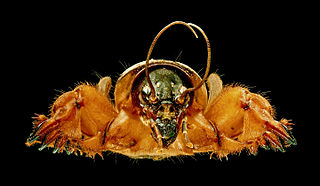
Gryllotalpa gryllotalpa, commonly known as the European mole cricket, is widespread in Europe and has been introduced to the eastern United States. The scientific name is derived from the Latin 'gryllus' meaning a cricket and 'talpa', a mole, and is descriptive because of the fine dense fur by which it is covered and its subterranean habits, and because of the mole-like forelegs adapted for digging, a good example of convergent evolution.
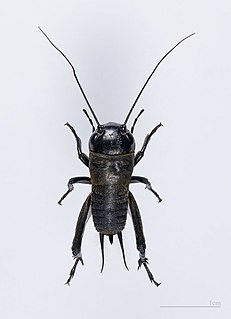
Crickets are orthopteran insects which are related to bush crickets, and, more distantly, to grasshoppers. In older literature, such as Imms, "crickets" were placed at the family level, but contemporary authorities including Otte now place them in the superfamily Grylloidea. The word has been used in combination to describe more distantly related taxa in the suborder Ensifera, such as king crickets and mole crickets.

Seismic or vibrational communication is a process of conveying information through mechanical (seismic) vibrations of the substrate. The substrate may be the earth, a plant stem or leaf, the surface of a body of water, a spider's web, a honeycomb, or any of the myriad types of soil substrates. Seismic cues are generally conveyed by surface Rayleigh or bending waves generated through vibrations on the substrate, or acoustical waves that couple with the substrate. Vibrational communication is an ancient sensory modality and it is widespread in the animal kingdom where it has evolved several times independently. It has been reported in mammals, birds, reptiles, amphibians, insects, arachnids, crustaceans and nematode worms. Vibrations and other communication channels are not necessarily mutually exclusive, but can be used in multi-modal communication.
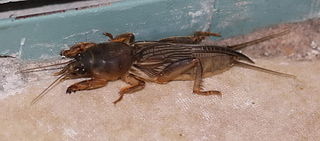
Gryllotalpa orientalis is a species of mole cricket in the family Gryllotalpidae, commonly known as the oriental mole cricket. It is found in much of Asia and Australasia. At one time, this species was misidentified as G. africana and thought to have a widespread distribution in both Africa and Asia, but in the 1980s, G. orientalis was recognised as a separate species. It is a polyphagous pest, damaging crops by gnawing their roots.
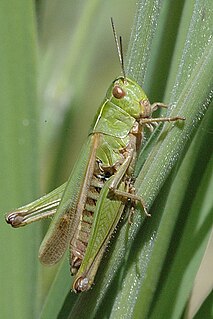
Omocestus viridulus, known in the British Isles as the common green grasshopper, is a Palearctic species in the subfamily Gomphocerinae.

Gryllus bryanti is a species of cricket in the subfamily Gryllinae. G. bryanti lives on islands in the Caribbean Sea, including Eleuthera Island and Andros Island in the Bahamas.

Gryllotalpa africana, also known as the African mole cricket, is a relatively small mole cricket species, native to Africa, but local populations exist in Asia, and southern Europe.
Scapteriscus abbreviatus, the short-winged mole cricket, is a species of insect in the mole cricket family, Gryllotalpidae. It is native to South America but has been introduced inadvertently into Florida, in the United States. Unlike other related species, it is unable to fly, nor do the males emit songs in order to attract females.

The New Zealand mole cricket is a wingless member of the mole cricket family Gryllotalpidae. Endemic to New Zealand, it lives underground and is rarely seen. It is now restricted to parts of the southern North Island.

















